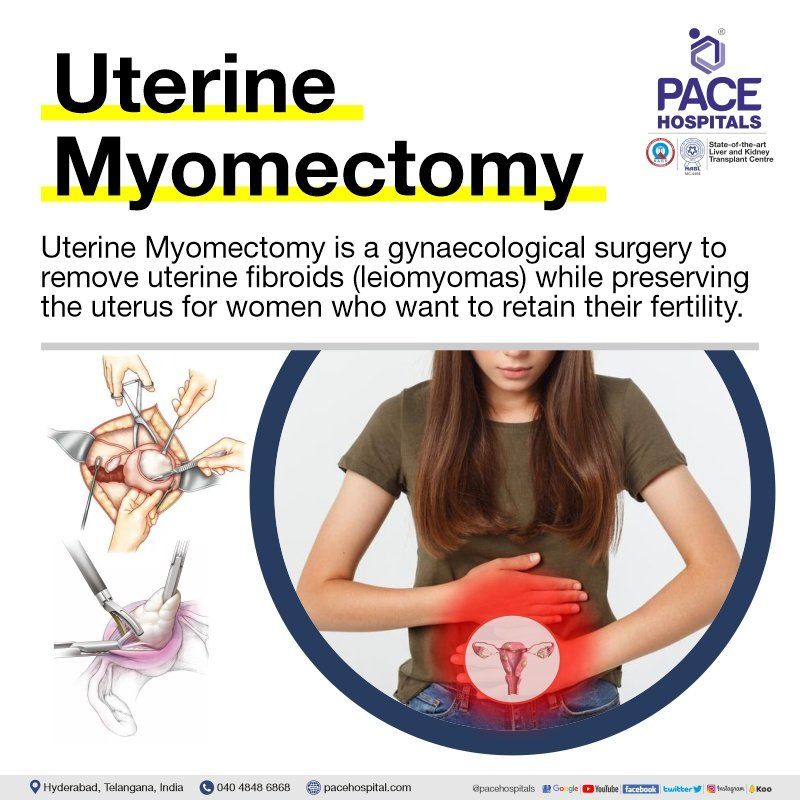Myomectomy Surgery - Procedure Indications, Side effects & Benefits
At Pace Hospitals, the state-of-the-art OT is equipped with AI Robotic Surgery system and world-class advanced 3D HD laparoscopic and laser equipment to perform minimally invasive major and supra-major gynecological surgery.
Our team of the best myomectomy doctors, laparoscopic gynecologist, obstetrics and gynecology doctors are having extensive experience in performing myomectomy surgery by open, laparoscopic and robotic techniques.
Request an appointment for Myomectomy surgery
Myomectomy surgery - appointment
What is Myomectomy and its purpose?
Myomectomy meaning
Uterine myomectomy is a gynaecological surgery to remove uterine fibroids (leiomyomas) while preserving the uterus. Uterine fibroids are the most prevalent benign tumour (common non-cancerous growths) in the female, it usually develops during reproductive years, but they can occur at any age.
Uterine fibroids or leiomyomata exert a considerable impact on women in reproductive age, resulting in heavy menstrual bleeding (menorrhagia), pelvic pain or pressure, and poor reproductive outcomes. Nevertheless, there are a considerable number of asymptomatic women across the globe (in whom symptoms do not manifest).
Although hysterectomy (surgical removal of partial or entire uterus) is usually the preferred surgical procedure for uterine fibroids, uterine myomectomy is the best surgical choice while leaving the uterus intact for women who want to retain their fertility.
What are the indications of Myomectomy surgery?
Some women (usually women without biological children) with uterine fibroids choose myomectomy over hysterectomy to improve fertility or preserving their uterus when no other obvious cause for subfertility (reduced fertility characterised by prolonged periods of unwanted non-conception) is present.
Myomectomy can be performed by three different techniques such as open, laparoscopic or robotic, making it an excellent choice for future fertility in women. The following are some indications of myomectomy surgery:
- Menometrorrhagia (when menstrual bleeding occurs outside the monthly cycle or extremely heavy and/or prolonged periods) result in anemia
- Pelvic pain and pressure
- Chronic pain in lower abdominal area, pelvic pressure and discomfort with large size uterine myoma seen in ultrasound
- Uterine myomas or fibroids that are abdominally palpable
- Enlarging fibroids with the possibility of malignancy (cancer)
- Ureteral obstruction
- Gestational size greater than 12 weeks and inability to evaluate adnexa (gynaecological organs around the uterus, - ovaries, fallopian tubes and neighbouring connective tissues)
Types of Myomectomy
Myomectomy surgery involves the abdominal incision (cut) for the surgical removal of uterine fibroids. Usually, cervix and uterus are left intact. There are majorly four types of myomectomy, includes:
- Open or Abdominal myomectomy
- Laparoscopic myomectomy
- Robotic myomectomy
- Hysteroscopic myomectomy
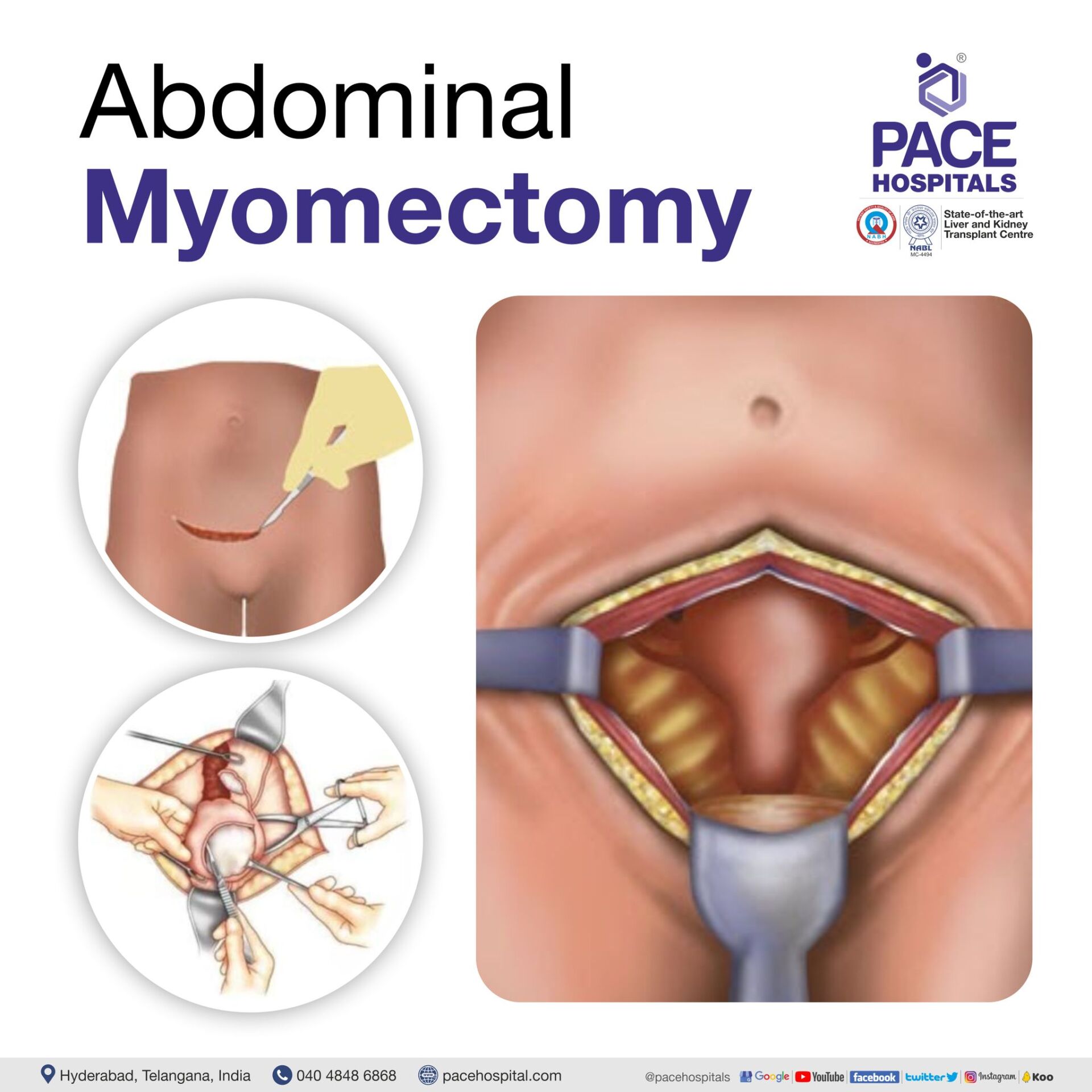
Open or Abdominal Myomectomy
Abdominal myomectomy (also called open myomectomy) is a major surgical procedure, uses a regular abdominal incision for conventional "open" surgery. It is typically performed to remove particularly huge, numerous, or subserosal or intramural fibroids, or when malignancy is suspected.
A "bikini cut" is an incision that is made through the skin of the lower abdomen. The uterus's wall's fibroids are surgically removed. With numerous layers of stitches, the uterine muscle is repaired.
Most women spend one to two nights in the hospital following surgery, followed by six to eight weeks of reduced activity. Abdominal myomectomies may carry higher risks of uterine scarring and blood loss than the less invasive techniques.
After an abdominal myomectomy, pregnancies may need to be delivered via C-section (Caesarean delivery) which lessens the possibility of uterine damage during labour.
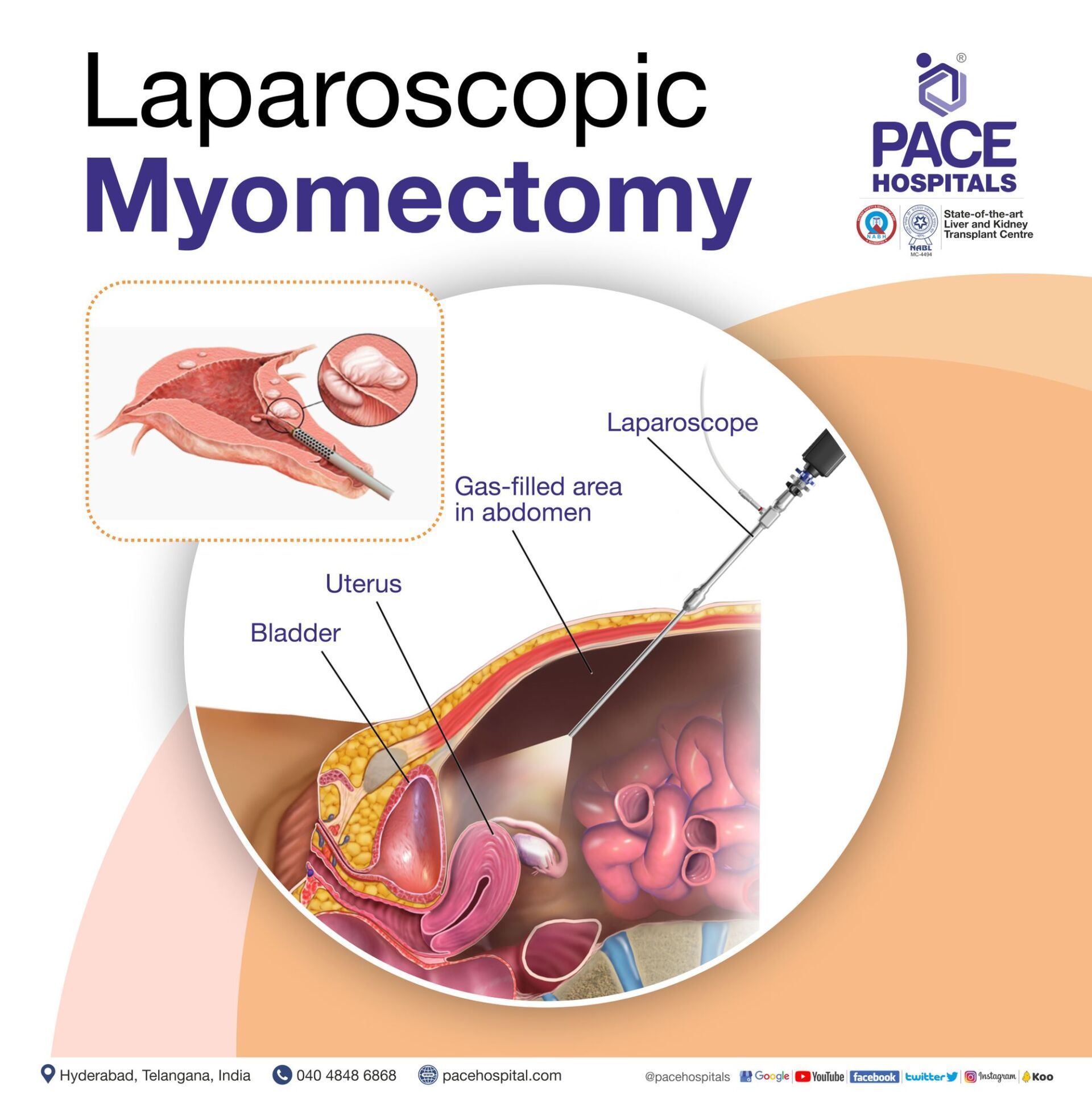
Laparoscopic Myomectomy
Women with fewer subserosal fibroids may be prepared for laparoscopic surgery. Thin scopes with surgical and viewing tools are utilised in laparoscopic myomectomy procedures. The lower abdomen is first incised four times, once below the belly button, once below the bikini line (around the pubic hair), and once near each hip. Gaseous carbon dioxide is then injected into the abdominal cavity.
Through an incision, a laparoscope, a small, illuminated telescope, is inserted to allow medical professionals to view the uterus, fallopian tubes, and ovaries. The fibroids are removed using long devices that are put via the other incisions. The uterine muscle is repaired through sewing. At the end of the procedure, the gas is released and the skin incisions are closed.
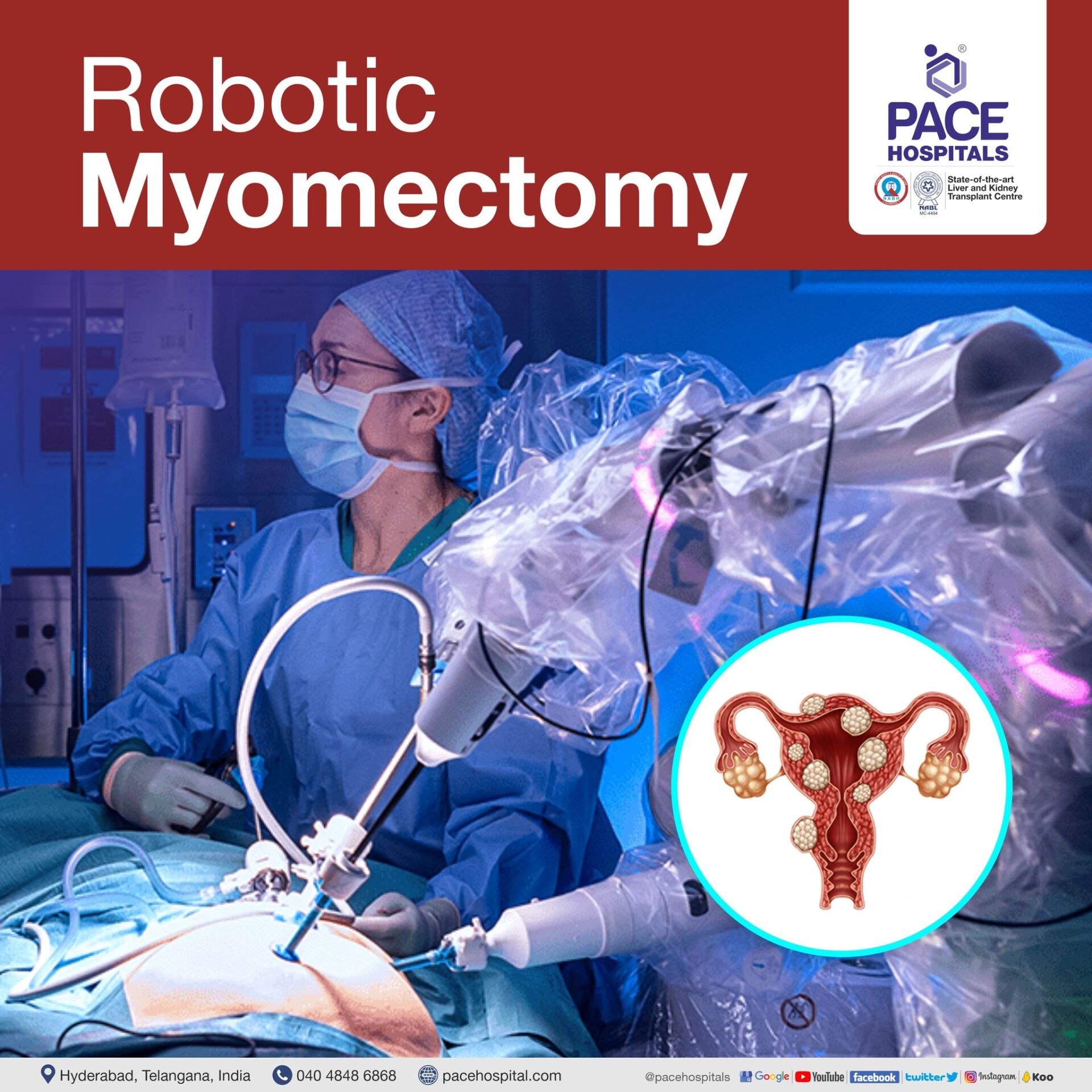
Robotic Myomectomy
Through this procedure a surgeon's ability to visualize the fibroids and the surrounding tissue, is improved as well as enhanced ability to stitch up the uterus when removing uterine fibroids and reconstructing the uterine wall. It does this by combining high-definition 3D magnification, robotic technology, and miniature instruments. Small surgical instruments and slim robotic arms can access the uterus through four abdominal incisions.
The surgeon removes the fibroids from the surrounding uterine tissue while using precise procedures to keep the bleeding to a minimum. Once the fibroid has been removed, the surgeon cuts it into tiny pieces within the patient's abdomen using a specialised tool called a morcellator. Then, through one of the ports, the fibroid parts are removed.
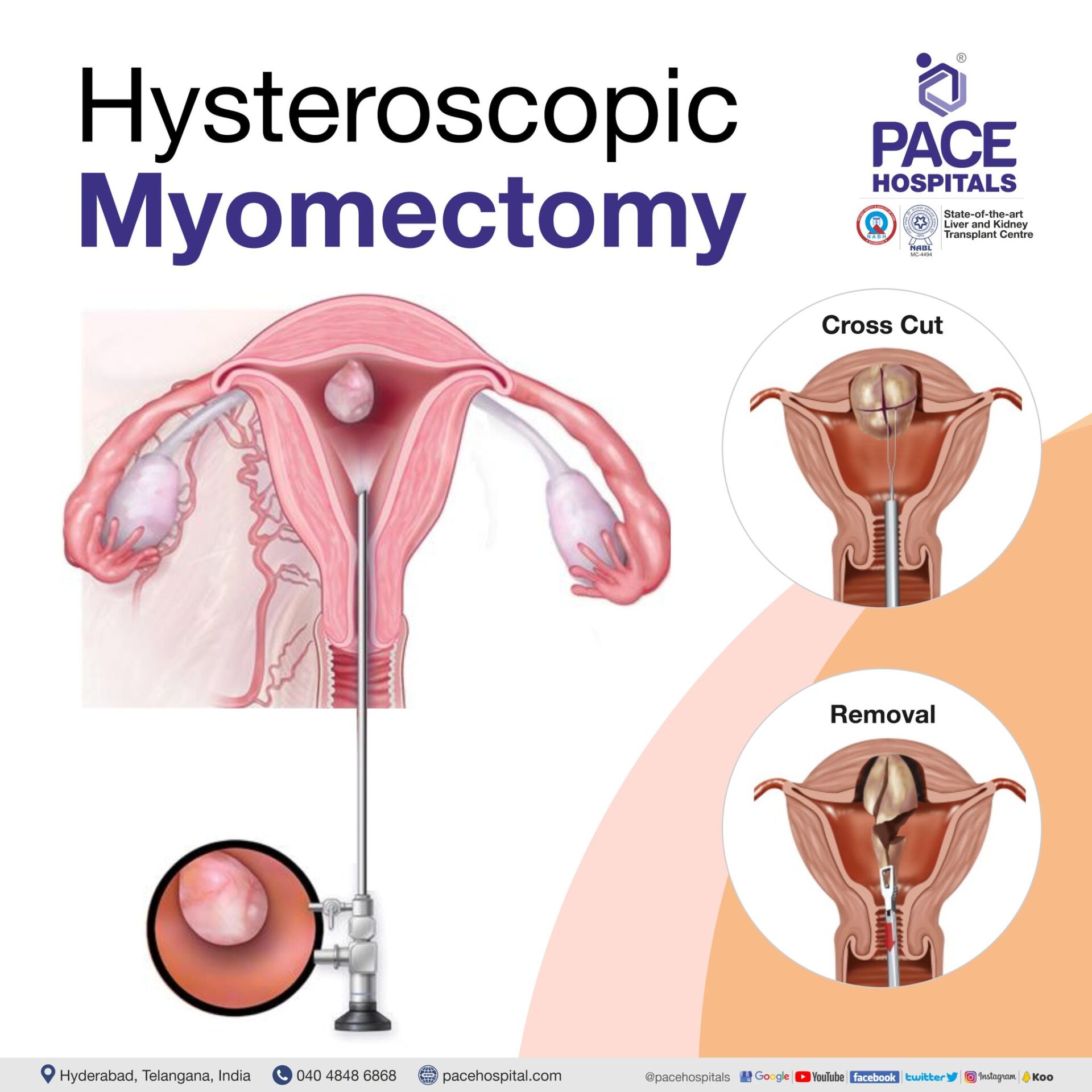
Hysteroscopic Myomectomy
Myomectomy with hysteroscope is generally performed for submucosal fibroids, the benign growths of the uterus and commonly seen during reproductive age of women. A hysteroscopic resectoscope is the instrument which can be inserted into the uterine cavity through the vagina and cervical canal for the removal of fibroids. During a standard resection, the fibroid is surgically removed using an electrosurgical wire loop.
This myomectomy is only appropriate for females with submucosal fibroids wishing to preserve their uterus or fertility. After spending a few hours in the observation, in the post-surgical room, patients can be sent home. In most cases, recovery just takes a few days. The skin is usually devoid of scars post-surgery.
Considerations of the surgeon / gynaecologist before performing myomectomy surgery
Preparing for the surgery
The primary care physician or gynecologist who will perform myomectomy will discuss the surgery's risks and benefits with you. Required laboratory tests for the surgery are being completed at least 3 days before surgery to avoid any last-minute hassles.
After that, you'll sign a consent form for the myomectomy surgery, acknowledging that you've read and understood the procedure. Before surgery, you will be informed about what to do and what to avoid.
These are some general points that you have to follow before surgery:
- You have to stop taking few of the ongoing prescriptions before the surgery recommended by the treating surgeon, and you may be prescribed a list of new drugs.
- Inform in advance about your allergies to your surgeon.
- Lifestyle changes such as smoking/drinking might hinder your recuperation after surgery, so it is preferable to stop smoking 6 to 8 weeks before surgery.
- The surgeon may ask you to either to fast the night before the surgery imaging tests. If not enema (expelling bowel contents by injecting liquid into the rectum) may be used.
During the surgery
- The anesthetist provides general anesthesia to you in the in the operating room.
- The myomectomy surgery begins once you are unconscious, A breathing tube will be inserted in your throat to assist with your breathing.
- To eliminate any gas and any additional materials another tube will be inserted into your stomach. This lessens the risk of harm during the surgery and the tube is taken out just before you wake up.
- Your bladder will be punctured with a catheter to drain your urine and to keep an eye on the amount of urine coming out. The catheter will remain in place overnight.
- In order to prevent blood clots, compression stockings will be applied to your legs during surgery, in your lungs and legs.
- The surgeon will identify and remove uterine fibroids during surgery after it has begun. Your incision will be closed after the procedure is finished, and a dressing will be applied to it.
After the surgery
- Post-surgery you will be shifted to the recovery room for monitoring for 6 to 8 hrs after the surgery, further you will be shifted to the hospital room.
- Depending on the length of the surgery, you might not be able to either eat or drink for a short time after the surgery is completed. You may be given a liquid diet and once you start feeling better, the regular diet can be resumed.
- It is normal to feel bloated or experience cramping. Nevertheless, explain the same to the healthcare professional in case anyway.
- The tubing used for anaesthesia could cause a scratchy or an irritated throat.
- You will be prescribed with drugs for pain and nausea if necessary.
- Compression stockings can be provided to improve circulation.
- Routine medications would be restarted.
- You can start walking once you feel better. It helps in healing and recovery.
- In addition, if the patient is in good health and is able to resume normal activities the next day, she may be discharged. However, a follow-up with the primary care doctor is important.
- Depending on your circumstances, the primary care doctor or gynaecologist may provide you the additional instructions following the surgery.
Complications of Myomectomy
Myomectomy surgery has low complications. Still, the procedure constitutes a set of unique challenges. The complications are different to various types of myomectomies performed. They also depend on the complexities of the individual cases. Complications of myomectomy varies on its type of methods used, which include:
- Scarring - Many women may develop abdominal scar if open myomectomy performed. Laparoscopic myomectomy has few scars than open myomectomy.
- Excessive loss of blood - Since many symptomatic women are already having low blood volume due to heavy menstrual bleeding, surgeons may advise to have good blood volume before surgery. In very few cases excessive blood loss and required blood transfusion during surgery have been reported with myomectomy procedure.
- Rare possibility of hysterectomy – Surgeon may perform hysterectomy over myomectomy if there are uncontrollable bleeding and other abnormalities of uterus apart from uterine fibroids.
- Postpartum or Pregnancy complications – Rarely there are complications associated during postpartum or pregnancy if surgery was performed meticulously. Surgeons may advise C-section (cesarean section) to avoid uterine rupture during labour.
- Rare chance of spreading a cancerous tumor – In a very few cases, cancerous tumor are mistaken as uterine fibroids. During morcellation process cancer can spread to nearby tissues, risk may increase after menopause and as women becoming older. It’s very important to do the all necessary investigations before the surgery to avoid this risk.
Open or abdominal myomectomy complications
- Surgical wound infection (bleeding, infection, visceral damage, and thromboembolism)
- Intraoperative blood loss depends on the size and location of uterine fibroids.
- Very few or almost nil intraoperative visceral injuries
- Unusually high incidence of fever occurring in the first 48 hours postoperatively
- The need to switch from a myomectomy to a hysterectomy during surgery represents the most significant short-term risk. Generally, there are two main causes for this phenomenon.
- First, there is no guarantee that the uterus can be reconstructed after having multiple small fibroids or one large fibroid removed.
- Secondly, if blood loss is too high during surgery, a hysterectomy may be performed.
As part of the informed consent process, all patients undergoing myomectomies should be informed of this possibility.
Laparoscopic and Robotic myomectomy complications
- Injury to bladder, bowel, ureter, and blood vessels
- The need to convert to a laparotomy. (Conversion rates can be extremely low or as high as 8-10%, depending largely on the complexity of the case.)
- Uterine rupture during labour is significantly more likely if the surgery wasn't properly closed.
Hysteroscopic myomectomy complications
- Haemorrhage
- Uterine perforation (injury to surrounding blood vessels, bladder or bowel)
- Damage to the cervix, and Excessive absorption of the distention media into the vascular system causing metabolic disturbances. (In hysteroscopic myomectomy either a gas (carbon dioxide) or liquid medium (normal saline, 5% dextrose) is used to distend the uterine cavity. Complications can arise if the medium is absorbed into the body)
- Excessive absorption of distension media is a potential complication of hysteroscopic myomectomy that can lead to pulmonary oedema (fluid in lungs), hyponatremia (low level of sodium in blood), cerebral oedema (swelling in the brain cavity due to fluids), and even death.
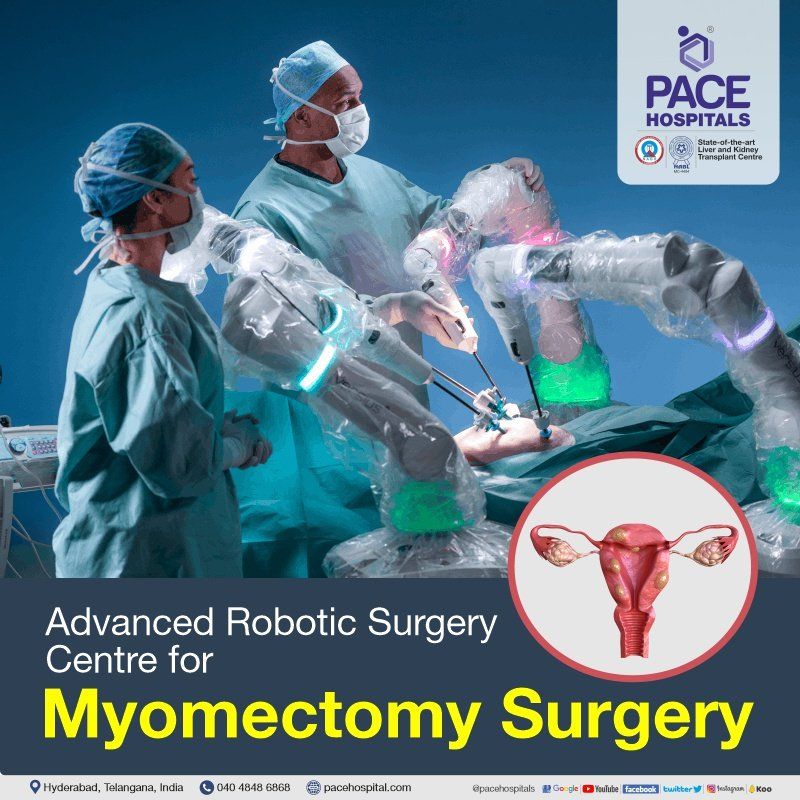
Comparison between Robotic myomectomy, Laparoscopic myomectomy and Abdominal myomectomy
Robotic myomectomy vs Abdominal myomectomy
Myomectomy has been the gold standard since 1931 for the conventional surgery for treatment of symptomatic fibroids in patients desiring biological children or uterine conservation. The robotic-assisted laparoscopic surgery is the latest development in the surgical treatment for uterine fibroids. The comparison of robotic myomectomy vs abdominal myomectomy are as follows:
| Conditions | Robotic myomectomy | Open or Abdominal myomectomy |
|---|---|---|
| Incision | Only 3 or 4 incisions | A large open cut at lower abdomen |
| Estimated blood loss | Around 80-250 mL | Around 200 to 800 mL |
| Hospitalization | Average recovery takes one day hospital stays and four weeks of limited activity. | One to two nights in the hospital following surgery, followed by six to eight weeks of reduced activity |
| Surgical discomfort | Minimal | Heavy |
| Wound infections | Very less chances | High chances |
| Post operative recovery time | Lesser time | More time |
Laparoscopic myomectomy vs Robotic myomectomy
To reduce bleeding symptoms apart from preserving fertility and treating one or more fibroids and can be done by laparoscopic myomectomy or robot-assisted laparoscopic myomectomy. Robotic-assisted laparoscopic surgery was introduced in the mid-2000s as the pinnacle of the minimally invasive approach. The robotic approach has modest benefits, but the has almost similar advantages when compared with laparoscopic myomectomy.
| Conditions | Robotic myomectomy | Laparoscopic myomectomy |
|---|---|---|
| Estimated blood loss | Significantly lesser | A large open cut at lower abdomen |
| Blood transfusions during surgery | No significant difference | No significant difference |
| Length of hospital stay | No significant difference | No significant difference |
| Complications | Significantly lesser | More |
Laparoscopic myomectomy vs Abdominal myomectomy
While abdominal myomectomy is considered a "classic" procedure for removing uterine fibroids, laparoscopic myomectomy has also seen widespread use in clinical practice due to its minimal invasiveness, shorter hospital stays, and quicker return to normal activities.
| Conditions | Laparoscopic myomectomy | Abdominal myomectomy |
|---|---|---|
| Intraoperative blood loss | Only 3 or 4 incisions | A large open cut at lower abdomen |
| Postoperative ileus (Prolonged absence of bowel function after surgical procedures) | Significantly shorter time | More time to heal Postoperative ileus |
| Hospitalization | Significant reduction in the length of hospital stay | Increased hospital stay than Laparoscopic myomectomy |
| The duration of operation | longer duration of operation | Shorter duration of operation |
| Case of Multiple fibroids | More appropriate for patients with multiple uterine fibroids | Less appropriate for patients with multiple uterine fibroids |
Frequently asked questions:
Is myomectomy surgery painful?
Post myomectomy, the patient may experience mild cramping. Majority of patients who underwent hysteroscopic myomectomy and laparoscopic myomectomy experience less pain than open myomectomy and are usually devoid of prescription pain medication. Over-the-counter pain medication (such as paracetamol) may be prescribed to manage the surgical pain. Your surgeon will talk with you about stronger pain medications if necessary.
How long to wait for IVF after myomectomy?
Delay in planning for pregnancy after myomectomy must be considered, as you need to allow the uterine wall to heal. In case of hysteroscopic myomectomy, the healing time is relatively short as it does not involve a myometrial incision, but it needs to be long enough for the fibroid bed to recover.
However, women are usually advised to avoid pregnancy for at least three months after abdominal myomectomies, resulting in delays in the planned IVF (In vitro fertilization) treatment. This may potentially be an issue for older women, particularly for those with reduced ovarian reserve. This delay may, however, be overcome by performing IVF before myomectomy and freezing the embryos for transfer after the recovery period.
Is myomectomy same as C-Section (Cesarean Section)?
No, myomectomy surgery involves the procedure of surgical removal of fibroids while C-Section (Cesarean Section) involves the procedure for the delivery of a baby through surgical incisions in the abdomen and uterus
What are the benefits of Myomectomy?
- Myomectomy is one of the commonly performed surgical procedure for uterine fibroids.
- Myomectomy is most suitable for the patients wishing to preserve their uterus for future and for the patients who wish to have biological children in future.
- The rate of successful live birth rate is higher in women who underwent myomectomy.
- No disturbance in the occurrence of menopause commencement.
What are the side effects of myomectomy surgery?
There are both advantages and disadvantages of Myomectomy. The disadvantages include:
- The chances of fibroid reoccurrence are not zero after myomectomy surgery.
- There is always a chance of myomectomy being converted into hysterectomy during mid surgery.
- There is no guarantee that the uterus can be reconstructed after having multiple small fibroids or one large fibroid removed.
What to eat after myomectomy surgery?
Depending on the length of the surgery, you might not be able to either eat or drink for a short time after the surgery is completed. You may be given a liquid diet and once the you start feeling better, the regular diet can be resumed
Can I get pregnant after myomectomy?
Yes, pregnancy is possible after myomectomy but it could be accompanied by an increased risk in miscarriage, preterm birth, abnormal placentation, C-section (Caesarean delivery), intrauterine adhesions, and uterine rupture.
Can I sleep on my side after myomectomy?
You can experience pain around the incision sites after your laparoscopic or abdominal myomectomy as they heal. For a few days to a few weeks following these surgeries, avoid sleeping on your sides or stomach until your incisions have healed.
Does myomectomy affect fertility?
Although hysterectomy (surgical removal of partial or entire uterus) is the usually preferred surgical therapy for fibroids, myomectomy is the best surgical choice for women who want to retain their fertility.
Does myomectomy affect menstrual cycle?
Menstrual cycle depends on various drugs you take such as progesterone containing drugs or hormonal birth control. Usually, a period occurs within three to four days after the myomectomy in patients who dropped taking these drugs, right before surgery.
How long after myomectomy can I have intercourse?
For at least two weeks after myomectomy, try not to indulge in intercourse. Depending on the type of myomectomy surgery, you may need to wait longer. Consult your surgeon about your abstinence.
How long does it take to recover from a myomectomy?
Most women spend one to two nights in the hospital following surgery, followed by six to eight weeks of reduced activity. Abdominal myomectomies may carry higher risks of uterine scarring and blood loss than the less invasive techniques.
What are the risks of myomectomy?
An abdominal myomectomy has some risks which are quite uncommon compared with other surgeries. Post-surgery, 5% of women experience infections requiring antibiotic treatment for up to 5 days in the hospital. Wound infections affect 5% of women on average. Although the wound infection can be managed at home, numerous doctor visits are necessary for up to six weeks.
After hysteroscopic myomectomy there are chances of fibroids recurrences exclusively for pre-menopausal women. Cramping and mild bleeding could be seen after the procedure.
Laparoscopic myomectomy risks are uncommon, but exist as internal organ damage and haemorrhage. Additionally, following surgery, your uterus can be weaker. It's also crucial to keep in mind that fresh fibroids could form, leading to repeated discomfort and more treatments.
How much does a laparoscopic myomectomy cost?
The average cost of laparoscopic myomectomy surgery in India is approximately 1,25,000 (Rupees one lakh twenty-five thousand only). However, laparoscopic myomectomy cost in India, ranges vary from Rs. 95,000 to Rs. 2,65,000 (Rupees ninety-five thousand to two lakh sixty-five thousands) depends upon the type, size and number of fibroids, the different private hospitals in different cities.
Laparoscopic myomectomy cost in Hyderabad ranges vary from Rs. 90,000 to Rs. 2,25,000 (Rupees ninety thousand to two lakh twenty-five thousands). However, cost of laparoscopic myomectomy surgery depends upon the multiple factors such as the size, number and type of fibroids, risks associated with the surgery, selection of room for hospital stay, CGHS, EHS, ESI, insurance or corporate approvals for cashless facility.
How much does a robotic myomectomy cost?
The average cost of robotic myomectomy in India is approximately 3,75,000 (Rupees three lakh seventy-five thousand only). However, robotic myomectomy cost in India, ranges vary from Rs. 3,50,000 to Rs. 5,25,000 (Rupees three lakh fifty thousand to five lakh twenty-five thousands) depends upon the size, number and type of fibroids, the different private hospitals in different cities.
Robotic myomectomy cost in Hyderabad ranges vary from Rs. 2,85,000 to Rs. 4,75,000 (Rupees two lakh eighty-five thousand to four lakh seventy-five thousands). However, cost of robotic myomectomy depends upon the multiple factors such as the size, number and type of fibroids, procedure time, risk and complications associated with the surgery, room selection for hospital stay, EHS, CGHS, ESI, corporate or insurance approvals for cashless facility.
How much does a hysteroscopic myomectomy cost?
The average cost of hysteroscopic myomectomy in India is approximately 68,000 (Rupees sixty-eight thousand only). However, hysteroscopic myomectomy cost in India, ranges vary from Rs. 56,800 to Rs. 1,30,000 (Rupees fifty-six thousand eight hundred to one lakh thirty thousands) depends upon the size and number of fibroids, the different private hospitals in different cities.
Hysteroscopic myomectomy cost in Hyderabad ranges vary from Rs. 48,600 to Rs. 1,15,000 (Rupees forty-eight thousand six hundred to one lakh fifteen thousands). However, cost of hysteroscopic myomectomy depends upon the multiple factors such as the number and size of fibroids, procedure time, and hospital room selection and corporate or insurance for cashless facility.
How much does an abdominal myomectomy cost?
The average cost of abdominal myomectomy in India is approximately 92,000 (Rupees ninety-two thousand only). However, abdominal myomectomy cost in India, ranges vary from Rs. 90,500 to Rs. 2,15,000 (Rupees ninety thousand five hundred to two lakh fifteen thousands) depends upon the size and number of fibroids, the different private hospitals in different cities.
An abdominal myomectomy cost in Hyderabad ranges vary from Rs. 80,000 to Rs. 1,85,000 (Rupees eighty thousand to one lakh eighty-five thousands). However, cost of abdominal myomectomy depends upon the multiple factors such as the number and size of fibroids, and hospital room selection and corporate or insurance for cashless facility.

